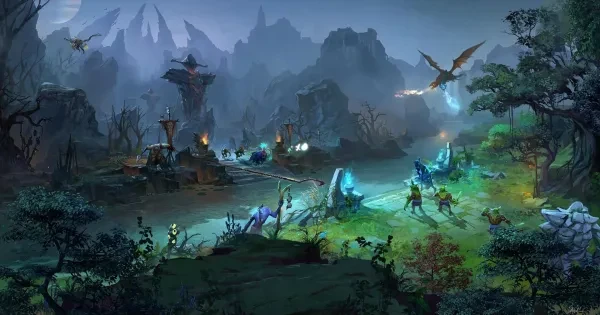Cartoons And Video Games Evolved Into Bitcoin And NFTs
[ad_1]
Bitcoin
BTC
Except that it’s all just minor variations of things that were created decades ago, grew into huge markets with the participation of a good part of the world’s population, and continue to grow today. Invention? Creativity? How about minor variations of proven ideas, giving them a new name and slightly different context, and getting super-rich?
From Drawing to Cartoons to Video Games
Drawing, sculpting and otherwise creating artificial images of the reality we experience has a long history.
For example, here’s a painting of a bovine from a cave created by early humans over 40,000 years ago:
Cave painting
Wikipedia
Drawings that suggest reality but are purposely different from real things are called cartoons, and go back hundreds of years, becoming more widespread in the 1800’s in print media.
Then there was a breakthrough: animation. Leveraging early movie technology, artists worked enormously hard to create a fast-changing sequence of images to create the illusion of motion. Along with sound, you could now go to a theater and watch and hear a whole cartoon movie, filled with characters and actions that could never happen in real life. Characters like Mickey Mouse and Bugs Bunny became part of modern culture.
The next big step took place after computers were invented and got video screens. Of course the computers transformed the process of creating animation. But animation was always like watching a movie: the human could only watch and listen. With computers, the possibility first arose for actions of the person to directly and immediately change what happened on the screen. The video game was born.
The video game has gone through an extensive evolution from the primitive, simple Space War to immersive MMORPG‘s
RPG
World of Warcraft (WoW) wasn’t the first, but became the most popular of the MMORPG’s.
“Similar to other MMORPGs, the game allows players to create a characteravatar and explore an open game world in third– or first-person view, exploring the landscape, fighting various monsters, completing quests, and interacting with non-player characters (NPCs) or other players. The game encourages players to work together to complete quests, enter dungeons and engage in player versus player (PvP) combat, however the game can also be played solo without interacting with others. The game primarily focuses on character progression, in which players earn experience points to level up their character to make them more powerful and buy and sell items using in-game currency to acquire better equipment, among other game systems.
World of Warcraft was a major critical and commercial success upon its original release in 2004 and quickly became the most popular MMORPG of all time, reaching a peak of 12 million subscribers in 2010.[4] The game had over one hundred million registered accounts by 2014[5] and by 2017, had grossed over $9.23 billion in revenue, making it one of the highest-grossing video game franchises of all time. The game has been cited by gaming journalists as the greatest MMORPG of all time and one of the greatest video games of all time.”
The industries creating hardware and software for these artificial worlds has grown to be huge. In 2020 video gaming generated over $179 billion in global revenue, having surpassed the film industry years before.
Video games aren’t just for kids. There are an estimated 3.24 billion gamers across the globe.
In the US the numbers are huge. “Three out of every four, or 244 million, people in the U.S. play video games, an increase of 32 million people since 2018.” Gamers spend lots of time on their games: “… gamers average 14 hours per week playing video games.”
Game World and Virtual Economies
Huge numbers of people go to a screen or put on a headset and “enter” the world of a video game, where they often spend hours at a time. While in that world, they can move from place to place as an observer, or as the controller of their personal avatar. They can interact with others, as shown by this scene from the virtual world of Second Life in 2003.
Second Life Metaverse
Wikipedia
Long before Bitcoin was created, video games had virtual economies with digital currencies.
The currency used in a game world can be called different things. For example in World of Warcraft it’s called — big shock coming up here — Gold. Gold can be earned by players accomplishing things in the game world, and can be spent for skills or in-game objects. Players can buy and sell items among themselves using such currencies. Many games enable players to buy in-game currencies using real money. In some cases, in-game virtual “land” is also for sale.
Long before Bitcoin, markets arose to enable in-game currencies to be traded (exchanged) for real-world currencies. It is now a multi-billion dollar industry. “In 2001, EverQuest players Brock Pierce and Alan Debonneville founded Internet Gaming Entertainment Ltd (IGE
IGE
Video Games, Bitcoin and NFT’s
The first Bitcoin was sent in 2009. It wasn’t much used or valued until 2013. Ether
ETH
Let’s see how the things used by literally billions of gamers compares to Bitcoin (and other crypto-currencies) and NFT’s.
- Games have digital currencies with no real-world value. Sounds like Bitcoin and other crypto-currencies.
- In-game virtual objects can be bought and sold using in-game currencies. Sounds like buying crypto-world NFT’s with Bitcoin.
- New units of the digital currency are created by the game software. New crypto is created by Bitcoin mining software.
- Game currencies can be used and exchanged among gamers. Same with Bitcoin.
- Game currencies can be exchanged for and bought with real-world money. Same with Bitcoin.
- There are exchanges outside the game that enable buying/selling. Same with Bitcoin.
- The exchange price can vary greatly. Same with Bitcoin.
- Teams create new games with currencies and virtual objects. Teams create new crypto-currencies and NFT’s.
Still think there’s no relationship between gaming and crypto? How about, as mentioned above, the fact that Brock Pierce and a partner founded the game currency exchange IGE in 2001, and the same Mr. Pierce was active in crypto-currency by 2013 and became a “Bitcoin billionaire” by 2018.
Of course, the new worlds of crypto and NFT’s are different in some important ways from the gaming worlds. Games along with the objects and currencies are created and managed by the game company. While there’s more control than is generally recognized, crypto-currencies have a large degree of self-management with their built-in miners. Similarly, NFT’s are created independently.
Conclusion
First Bitcoin came seemingly out of nowhere in 2009. A few years later, variations of Bitcoin appeared on the market. An astounding explosion of crypto followed, along with digital objects that “live” in the crypto world.
Like many other “brand new” things, the worlds of crypto and NFT’s have remarkably close relations to the world of gaming, from which they appear to have evolved. Compared to the gaming world, the number of people invested in crypto is truly tiny, hundredths of a percent. But the inflation and amount of real-world currency that has been converted to crypto dwarfs the amounts in the gaming world.
As with many other tech trends, the history and evolution of the elements of the trend reward study.
[ad_2]
Source link








